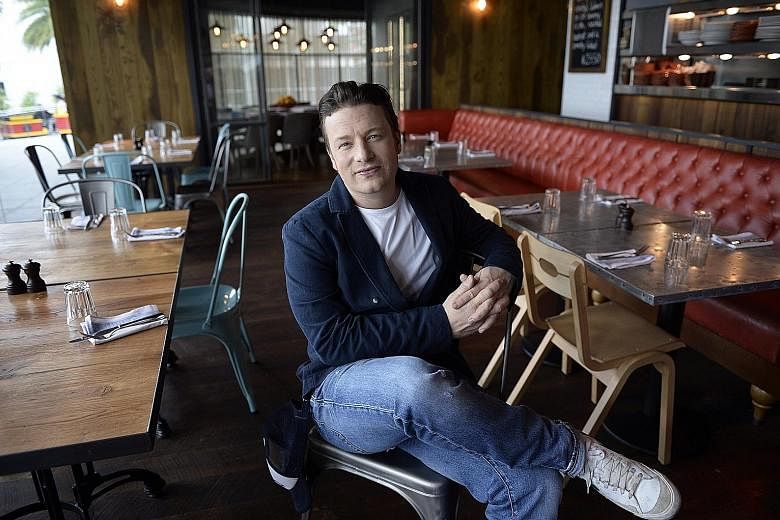LONDON • Jamie Oliver's wife set social media abuzz in December when she posted pictures of their seven-bedroom home in London's rarefied Hampstead.
The celebrity chef has built a £150-million (S$280-million) fortune from a business spanning books, television, endorsements and restaurants.
But as fans admired his home, he was battling to prevent the roof from caving in at Jamie's Italian, the centrepiece of his restaurant division. In December, he pumped £3 million of his money into the business. Last month, the chain said it would close 12 of its 37 British branches.
Court documents showed debts of £71.5 million and that staff were owed £2.2 million.
When Jamie's Italian opened its first branch in 2008 in Oxford, customers lined up outside to sample its rustic Italian staples with a "Jamie-style twist".
The Guardian praised it for good food, fair prices and large portions. The business expanded, peaking at more than 40 branches.
So where did it all go wrong? Warning signals emerged early last year when Jamie's Italian blamed competition and rising costs for the closure of six branches.
When accounts for 2016 were published in October, the business had slumped to a £9.9-million pre-tax loss from a profit of £2.4 million a year earlier.
The loss was caused mainly by the costs of branch closures and handing back a lease for a site in King's Cross where Oliver had scrapped plans for a restaurant, pub and head office complex.
The accounts said the chain's remaining branches were outperforming the market and that the brand "remains incredibly strong".
But the restaurant business' chief executive left in October. The business was brought under the wing of Mr Paul Hunt, husband of Oliver's sister Anna-Marie. Oliver is now said to be more involved with the restaurant business.
To some extent, the troubles at Jamie's Italian reflect those affecting the market for casual dining.
Business boomed as the economy picked up after the financial crisis. But a glut of openings led to intense competition, combined with rent rises and higher food prices.
Mr Peter Martin, vice-president at food and drink consultancy CGA, said savvy operators such as Nando's and JD Wetherspoon have remained successful by adapting to changing tastes.
The court documents for Jamie's Italian paint a picture of underinvestment, complex menus and ill-judged branch openings.
The crisis at Jamie's Italian has followed a series of business setbacks for Oliver, who by his own admission has lost £90 million of his wealth since 2014 .
In 2015, he shut the last branch of Recipease, his chain of cookery shops. Last year, he closed the last of his four British-themed Union Jacks restaurants. And in October, his food magazine, Jamie, stopped publishing after almost 10 years.
There may be further trouble ahead. He has put both branches of Barbecoa, his upmarket barbecue chain, up for sale.
Yet, away from his restaurants, his business continues to make plenty of money. At Jamie Oliver Licensing, which covers his endorsements and range of products and tie-ups, pre-tax profit rose to £7.3 million from £7 million in 2016.
Profit at Jamie Oliver Holdings, which covers his media interests, rose to £5.4 million from £1 million.
Oliver paid himself £10 million in dividends for the year - £6 million from licensing and £4 million from media. He has never taken money from the restaurant business.
Mr Paolo Aversa, associate professor of strategy at Cass Business School in London, said Oliver's business is essentially a brand built around his personality with a restaurant operation running alongside.
"You can argue that a company that sells an idea of better eating habits, healthy food and so on should have some kind of flagship business that reminds the customer where this all comes from," Mr Aversa added.
"I think Jamie's Italian reinforced the image and it still does to a certain extent. The question is: Is it worth the financial underperformance?"
GUARDIAN

